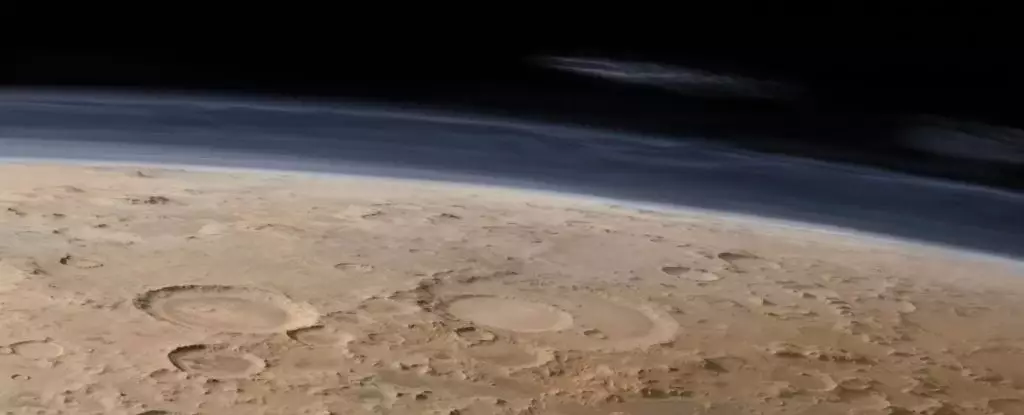Mars, the red planet that has fascinated humanity for generations, holds secrets about its history that are still being uncovered today. Recent research led by Shannon Curry of the University of Colorado Boulder has made significant strides in understanding one of the planet’s most perplexing phenomena—atmospheric sputtering. After nearly a decade of sifting through satellite data, scientists have captured this intricate process in action, revealing essential clues about the reasons behind Mars’ atmospheric erosion and, consequently, the disappearance of its once abundant water.
Understanding Sputtering: The Mechanism at Play
At its core, atmospheric sputtering is a process that involves the stripping away of atmospheric particles due to impacts from charged particles known as ions. In simpler terms, think of sputtering as a cosmic game of billiards: the solar wind acts as the cue ball, smashing into the Martian atmosphere and sending neutral particles flying into space. This escape of atoms, particularly during periods of intense solar activity, has been recognized as a critical mechanism in the loss of planetary atmospheres, particularly for bodies like Mars that lack a global magnetic shield to protect them.
During the early Solar System, when the Sun was more energetic and experiential, the effects of sputtering would have been significantly pronounced. The findings reported by Curry and her colleagues suggest that this process still plays a prominent role today, operating at levels four times higher than previously believed. The implications of this discovery stretch beyond mere atmospheric loss; they touch on the core questions surrounding Mars’ potential for habitability.
Deciphering Data: The MAVEN’s Contribution
The breakthrough in understanding atmospheric sputtering has largely been facilitated by NASA’s MAVEN (Mars Atmosphere and Volatile Evolution) spacecraft, which has been orbiting Mars since 2014. Equipped with sophisticated instrumentation capable of simultaneously observing both the Martian atmosphere and the solar electric field, MAVEN provides unique insights into the dynamic interactions at play. By analyzing the varying density of argon isotopes at different altitudes above the planet, researchers have pointed to active sputtering as the definitive explanation for these measurements.
This approach required an astute understanding of not just the atmospheric composition but also the solar influences that affect it. Unlike more straightforward observational data, capturing the sputtering phenomenon necessitated precise timing and coordination, emphasizing the analytical reach needed in modern planetary science.
Sputtering Patterns and Solar Storms
The study’s most compelling evidence emerges from specific solar storm events, such as the significant storm observed in January 2016. During these periods, the sputtering effect intensified dramatically, lending weight to the argument that ancient Martian conditions were vastly different from what we experience today. In this sense, the solar environment billions of years ago could have essentially acted as a turbocharger for atmospheric loss.
Researchers noted that the variance in argon densities correlated with the solar wind’s orientation, showcasing the intricacies of Mars’ atmospheric dynamics. The depletion of lighter isotopes while heavier ones lingered is particularly telling; this imbalance hints at a chaotic history wherein sputtering played a critical role, aiding researchers in piecing together the narrative of Mars’ climatic evolution.
Broader Implications for Habitability
The implications of these findings extend well beyond mere curiosity. Understanding atmospheric sputtering enhances our grasp of Mars’ history and informs our search for extraterrestrial life. Water, a key ingredient for life as we know it, likely once flowed abundantly on the Martian surface, but if sputtering was responsible for depleting the atmosphere, it fundamentally alters the conditions of habitability. If Mars was once a thriving world, the query transforms into why and how it became the barren environment we observe today.
Moreover, insights into atmospheric processes on Mars can offer parallels in understanding atmospheric loss on exoplanets, bringing us closer to recognizing potential habitability in worlds beyond our Solar System. The mechanisms at play, whether through sputtering or other atmospheric interactions, could very well provide a blueprint to evaluate environments where life could develop—or where it might have existed and subsequently perished.
Ultimately, the work of scientists like Chandler Curry opens new doors to our understanding of planetary evolution, showcasing just how vital these studies can be not only for Mars but for the broader cosmic tapestry of life itself.


Leave a Reply